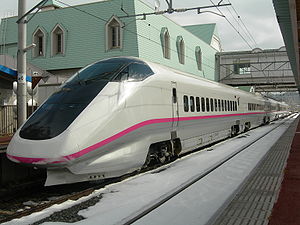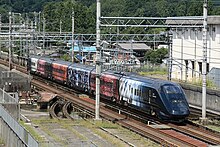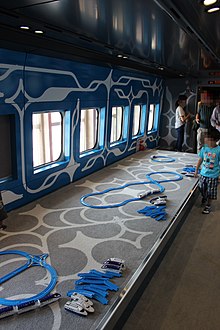Shinkansen series E3
| Shinkansen series E3 | |
|---|---|
|
Series E3
|
|
| Number: | R variant: 26 L variant: 15 |
| Manufacturer: | Kawasaki HI , Tokyu Car Corporations |
| Year of construction (s): | 1995-2010 |
| Gauge : | 1435 mm ( standard gauge ) |
| Length over coupling: | 149 m (R variant) 169 m (L variant) |
| Length: | End car: 23,400 mm Middle car: 20,500 mm |
| Height: | 4080 mm |
| Width: | 2,950 mm |
| Trunnion Distance: | 17,500 mm |
| Bogie axle base: | 2,500 mm |
| Payload: | 258 t (R variant) 308 t (L variant) |
| Top speed: | 275 km / h (Tōhoku coupled with E2 ) 240 km / h (Tōhoku coupled with E4 ) 130 km / h (Akita / Yamagata) |
| Continuous output : | 4,800 kW (R variant) 6,000 kW (L variant) |
| Acceleration: | 0.44 m / s² (1.6 km / h / s) |
| Wheel diameter: | 860 mm |
| Power system : | 25 kV / 20kV 50 Hz AC |
| Power transmission: | Overhead line 2 pantographs |
| Number of traction motors: | 16 (R variant) 20 (L variant) |
| Brake: | Engine brakes , disc brakes |
| Train control : | ATC-2, DS-ATC, ATS-P |
| Seats: | 23/338 (R variant), (1st / 2nd class) 23/394 (L variant) |
| Classes : | normal (2nd class), Green Class (1st class) |
The Shinkansen series E3 (Japanese E3 系 新 幹線 電車, E3-kei Shinkansen densha) is a Japanese high-speed train operated by JR East , which was built between 1995 and 2010 and whose first models were on the Akita Shinkansen , later models also on the Yamagata Shinkansen are used.
history
Like the 400 series before, the E3 series was developed for a mini Shinkansen route. Mini-Shinkansen lines are railway lines in Japan where conventional lines have been converted from Cape gauge to standard gauge in order to establish a connection to the Shinkansen network. The trains can be as on the actual Shinkansen high-speed line through bound to be. However, when the existing lines were converted, the clearance profile was not changed, so that the existing Shinkansen trains could not be used.
The E3 series was developed for the Akita Shinkansen, which opened in 1997. In 1995 the pre-series S8 train manufactured by Kawasaki Heavy Industries was delivered and then subjected to extensive tests. The pre-series train consisted of five cars and was converted to series standard before the opening of the Akita Shinkansen and floated in as an R1 set.
The top speed of the E3 series is 275 km / h, which it achieves on the Tōhoku Shinkansen in traction with E2 series trains . On the Akita and Yamagata Shinkansen, the speed limit is 130 km / h.
business
The trains of the first E3 series are used as a Komachi connection on the Akita Shinkansen. Between Akita and Morioka they run solo, from Morioka in traction with the trains of the Hayate connection of the Tōhoku Shinkansen .
The trains of the series E3-1000 and E3-2000 were procured to replace the series 400. They are therefore used as a Tsubasa connection on the Yamagata Shinkansen.
Series
First E3 series
The series vehicles based on the pre-series R1 were manufactured from 1996. Originally 16 vehicles were procured. The procurement was not carried out directly by JR East, but by Akita Shinkansen Sharyō Hoyū (Japanese 秋田 幹線 車 両 保有 (株)), a joint venture between JR East and Akita Prefecture . The trains were leased by JR East from Akita Shinkansen Sharyō Hoyū .
The R1 to R16 sets procured first initially had five cars. Due to increasing demand, a sixth car was added in 1998.
While the pre-series train still had three scissor pantographs, the series models were only equipped with two single-arm pantographs.
Duration
| set | delivery | Supplement to carriage 14 | Retirement | Remarks |
|---|---|---|---|---|
| R1 | March 28, 1995 | October 29, 1998 | August 26, 2013 | Pre-series train S8, originally with five cars and three pantographs |
| R2 | October 9, 1996 | November 1, 1998 | December 13, 2013 | On delivery 5-car trains, 6th car with no. 14 added in 1998 |
| R3 | October 14, 1996 | November 4, 1998 | 17th February 2014 | |
| R4 | October 22, 1996 | November 6, 1998 | January 9, 2014 | |
| R5 | October 28, 1996 | November 9, 1998 | April 26, 2013 | |
| R6 | November 6, 1996 | November 12, 1998 | April 12th, 2013 | |
| R7 | November 11, 1996 | November 22, 1998 | 17th May 2013 | |
| R8 | November 15, 1996 | November 24, 1998 | May 24, 2013 | |
| R9 | November 22, 1996 | November 26, 1998 | June 7, 2013 | |
| R10 | 2nd December 1996 | November 28, 1998 | August 27, 2013 | |
| R11 | December 12, 1996 | October 30, 1998 | September 13, 2013 | |
| R12 | December 21, 1996 | November 17, 1998 | November 27, 2013 | |
| R13 | January 20, 1997 | 5th December 1998 | 19th October 2013 | |
| R14 | January 30, 1997 | November 14, 1998 | December 1st, 2013 | |
| R15 | February 7, 1997 | November 16, 1998 | January 28, 2014 | |
| R16 | February 17, 1997 | November 19, 1998 | March 8, 2014 | |
| R17 | September 30, 1998 | Newly built 6-car trains | July 26, 2013 | |
| R18 | October 23, 2002 | Conversion 2014 to series E3-700 Toreiyu | ||
| R19 | November 18, 2002 | Conversion 2016 to series E3-700 Genbi Shinkansen | ||
| R20 | March 24, 2003 | 17th December 2015 | ||
| R21 | September 16, 2003 | |||
| R22 | October 27, 2003 | |||
| R23 | December 1, 2003 | Conversion 2014 to set L55 | ||
| R24 | April 4, 2005 | Conversion 2014 to set L54 | ||
| R25 | July 11, 2005 | Conversion 2014 to set L54 | ||
| R26 | July 26, 2005 | Conversion 2014 to set L55 |
E3-1000 series
When additional vehicles were needed for the Yamagata Shinkansen in the late 1990s, JR East decided to have a sub-series of the E3 series produced. Three vehicles of the E3-1000 series were produced, which consist of seven cars. The color scheme corresponds to the 400 series, but in the E3-1000 series the logo of the Tsubasa connection (a large wing) was also affixed to the power cars .
Originally, the trains of the E3-1000 series were operated from Fukushima in traction with trains of the E4 series at a maximum of 240 km / h. Since March 17, 2012, they have also been operated in traction with the E2 series and for this purpose have been upgraded to 275 km / h.
Between the end of 2014 and the beginning of 2015, the two oldest sets of the series E3-1000 L51 and L52 were replaced by the two sets L54 and L55, which were newly compiled from the R series. In 2015, a new paint job was also introduced for the Tsubasa connection.
Duration
| set | Manufacturer | delivery | Repainting | Retirement | Remarks |
|---|---|---|---|---|---|
| L51 | Tokyu Car | August 11, 1999 | - | 5th September 2014 | |
| L52 | Kawasaki HI | September 11, 1999 | - | 4th February 2015 | |
| L53 | Tokyu Car | August 17, 2005 | November 24, 2015 | ||
| L54 | Kawasaki HI | July 30, 2014 | NN | Conversion from sets R24 + R25 | |
| L55 | J-TREC | January 13, 2015 | NN | Conversion from sets R23 + R26 |
E3-2000 series
The E3-2000 series was procured as a replacement for the aging 400 series vehicles. Like the E3-1000 series, the E3-2000 series trains consist of seven cars. Between December 2008 and summer 2009 all trains of the 400 series were replaced by the E3-2000 series. 12 trains of the E3-2000 series were procured.
Compared to the E3-1000 series, a number of technical improvements have been implemented: The E3-2000 series trains have active suspension, LED direction indicators and sockets at all seats.
In contrast to the E3-1000 series, a row of four seats was removed from each of the control cars in order to create the same seat spacing in all cars. In the E3-1000 series, the rows of seats in the cars that do not require a reservation are narrower than those in the cars that require a reservation.
In 2015 and 2016, all sets were repainted in the new Tsubasa color scheme.
Duration
| set | Manufacturer | delivery | Repainting |
|---|---|---|---|
| L61 | Kawasaki HI | October 9, 2008 | July 6, 2016 |
| L62 | Kawasaki HI | December 9, 2008 | |
| L63 | Kawasaki HI | January 7, 2009 | November 24, 2015 |
| L64 | Kawasaki HI | February 17, 2009 | April 25, 2014 |
| L65 | Kawasaki HI | March 3, 2009 | June 6, 2014 |
| L66 | Kawasaki HI | March 25, 2009 | October 22, 2014 |
| L67 | Tokyu Car | March 28, 2009 | November 12, 2014 |
| L68 | Kawasaki HI | April 14, 2009 | 5th December 2014 |
| L69 | Kawasaki HI | May 19, 2009 | February 23, 2015 |
| L70 | Kawasaki HI | June 30, 2009 | April 6, 2016 |
| L71 | Kawasaki HI | July 22, 2009 | April 24, 2016 |
| L72 | Kawasaki HI | March 25, 2010 | 18th September 2015 |
E3-700 series Toreiyu
The R18 set was converted for tourist purposes in 2014 and has since been used as an excursion train on the Yamagata Shinkansen between Fukushima and Shinjō. The train is marketed as Toreiyu (と れ い ゆ), which is a suitcase word from the English word "Train" and the French word "Soleil" (sun). The train was designed by industrial designer Ken Okuyama.
The train consists of a standard car (2x2 face-to-face seating), two carriages with tatami floors, a lounge car with a bar and a car with Ashiyu foot baths. The train has a total capacity of 143 passengers. Most of the time, the train operates on special Toreiyu Tsubasa connections on weekends .
E3-700 series Genbi Shinkansen
The former R19 set was also converted into the Genbi Shinkansen (Japanese 現 美 新 幹線, Shinkansen for contemporary art) for tourism purposes . The train has been in service on the Jōetsu Shinkansen between Echigo-Yuzawa and Niigata since April 29, 2016, mainly on weekends. Photographer Mika Ninagawa was responsible for the external design of the train . The interior of each car was designed by a different artist:
| dare | function | Artist | art | photo |
|---|---|---|---|---|
| 11 | 2 + 2 seating | Nao Matsumoto | Interior design of seat cushions, sun visors and carpet | |
| 12 | Showroom | Yusuke Komuta | Installation of mirrors that reflect the landscape through which the train is traveling | |
| 13 | Children's play area and café | Kentaro Kobuke | Interior design of children's play area and cafe | |
| 14th | Showroom | Naoki Ishikawa | Photographs of alpine landscapes | |
| 15th | Showroom | Haruka Koujin | Abstract art | |
| 16 | Showroom | Brian Alfred | Short film about the Niigata region |
Web links
Individual evidence
- ↑ a b c d 高速 鉄 道 物語 - そ の 技術 を 追 う - (Tale of high-speed traffic). Seizandō Syoten, Japan 1999, ISBN 4-425-92321-9 , p. 57
- ↑ JRR 2006: JR 電車 編成 表 '07 冬 号. ISBN 4-88283-046-9
- ↑ 仙台 支 社 山形 新 幹線 「つ ば さ」 用車 両 (E3 系 2000 番 台) の 報道 公開 の ご 案 内 に つ い て ( Memento of the original from May 17, 2013 in the Internet Archive ) Info: The archive link was automatically inserted and not yet checked. Please check the original and archive link according to the instructions and then remove this notice. (PDF, Japanese; 458 kB)
- ↑ Japan Railfan Magazine 49, 584 (2009): つ ば さ の 世代 交代














